Text

Standing Figurine 800/400 B.C.
In the Gulf Coast lowlands of Veracruz and Tabasco between 900 and 400 B.C., Olmec rulers built cities with ceremonial earthen pyramids, platforms, and plazas. Monumental sculptures depict rulers and mythological themes, while small-scale figurines and related works commemorate important events. This figurine was found near the Coatzacoalcos River during the 1960s. It is carved in the style of figurines from a ritual offering at the major capital La Venta. These may have marked a rite of passage, when young men were initiated into office as rulers, warriors, priests, or traders in the stratified Olmec society.

EXAMPLES

Seated Female Figure 800/400 B.C.

Cup with Profile Head of the Maize God 800/400 B.C.

Roller Seal 800/400 B.C.

Roller Seal 800/400 B.C.

Spouted Dish with King Vulture Heads
800/400 B.C.
0 notes
Text

Mural Fragment Representing a Ritual of World Renewal Date:
A.D. 500/600
The ancient Mexican city of Teotihuacan was once the largest city in all of the Americas. The pomp and color of this great city were expressed most distinctively through its monumental architecture. Facades of pyramids and interiors of palaces, temples, and homes were frequently decorated with splendid frescoes. The fragment shown here was part of a cycle painted on the interior walls of an aristocratic palace. It shows a rain priest walking or dancing in profile and wearing an elaborate headdress and costume. His speech-scroll, adorned with seashells and plants, indicates that he is praying for water and agricultural prosperity, which were highly valued in his society.
Meaning “place of the gods,” Teotihuacan was the largest religious, military, and trading city in the Americas between A.D. 200 and 650, and it was inhabited by over one hundred thousand people at its peak. Designed with colossal pyramids and ritual plazas, the metropolis was built on a cosmologically oriented grid plan that embraced residential and manufacturing districts. This richly symbolic fragment from a Teotihuacan wall fresco depicts a ceremony that took place once every fifty-two years, a “century” in the ancient Mexican calendar system. A priest stands before a tied bundle of reeds representing the completion of a cycle of time. The bundle is impaled by the spiny points of maguey cactus leaves, with which the priestly protagonist of the scene has pricked himself to provide a blood offering. Water symbols in the form of shells and flowers are depicted within the speech-scroll curling from the priest’s mouth. Additional flowers and water are sprinkled from one of the priest’s hands, while in the other he holds an incense bag. Corresponding to the chants of a religious litany, this complex image was repeated with others on the walls of a chamber as a prayer of thanksgiving and for the renewal of agricultural fertility.

AZTEC NEW FIRE CEREMONY CODEX

Mask from an Incense Burner Portraying the Old Deity of Fire (Huehueteotl) A.D. 450/750

Shell Mosaic Ritual Mask
AD 300/600
Teotihuacan, the ruins of which are located near Mexico City, was one of the largest and most complex cities in the world during the first millennium AD. Although this mask shares features common to others from the city—a broad forehead, prominent nose, receding chin, and widely spaced cheekbones—it is subtly unique, indicating that it may represent a stylized portrait. Tied to wooden armatures adorned with feathers, jewelry, and garments, such masks were displayed in residential compounds and temples where they were the focus of rituals commemorating ancestors who acted as intermediaries between the living and the deified forces of nature. An older, recut stone mask was covered with mosaic tiles made from the inner layer of spondylus shell imported from the Pacific coast. The use of this exotic material suggests the far-reaching power, author¬ity, and wealth of Teotihuacan. Spondylus was also considered sacred, associating this mask and the individual it honors with the generative power of lakes, rivers, and the sea.

Ritual Mask A.D. 300/750




Bowl Depicting a Ritual Figure and Flaming Torches A.D. 300/600
Teotihuacan ceramic vessels were often fired and coated with a fine plaster that was then painted with figures and symbolic elements. This technique was derived from methods employed by mural painters, who covered masonry walls with fine plaster to serve as the ground for large-scale frescoes. The flaming torch may well allude to the ceremony of New Fire, kindled at New Year’s festivals and every 52 years at the inauguration of a new “century” in the native calendar system.

Tripod Vessel with a Blowgunner Scene
A.D. 300/500

Mirror with Jaguar or Coyote Mosaic Date:
A.D. 500/600
For over 2,000 years, polished stone mirrors were an important component of Mesoamerican attire, ritual, and symbolic imagery. This mirror is made of a single sheet of polished pyrite stone and includes a jade jaguar mosaic at its center. Mirrors often functioned as emblems of rank and office and were typically worn at the small of the back. The depiction of such mirrors in ancient murals, as worn by warriors, priests, and state officials, attests to their importance in the spectacular art of ritual performance in Teotihuacan.

Double-Chambered Vessel A.D. 100/700
Incense Burner

Figurine c. A.D. 400



Thin Orange Ware Tripod Vessel A.D. 900/1100


1 note
·
View note
Text
ANCIENT GULF COAST: REMOJADAS, VERCRUZ, TOTONAC (200 BC-800 AD) REMOJADAS

Standing, “Smiling” Figure with Hands Raised
A.D. 600/900


Figure of a Seated Leader A.D. 300/600
This naturalistic figure ranks among the finest works of the Remojadas sculptural tradition. The artist modeled the face of a youthful chieftain as an idealized type, yet there is also a sense of individual portraiture. Sitting cross-legged, with arms extended to the knees, the young ruler’s body conveys tension. He is elegantly dressed with an elaborate turban, belt, and skirt. The jewelry adorning his wrists and neck represents flowers, while the embroidery of the belt likely signals his rank and status.
Sophisticated clay technology was used to create this masterpiece. The head and neck were modeled separately and fitted into the top of the body, with soft clay added to smooth and strengthen the seam. The arms and legs were made of hollow tubes, while the flowers and belt ornaments were prepared from small bits of clay pressed to the moist surface. After the assembled figure completely dried, it was fired. The naturalistic rendition of the human form, close attention to human expression, and technological command of the material attest to a mature artistic tradition and an accomplished sculptor.

Portrait Head A.D. 250
VERACRUZ
EL TAJIN BALLCOURT

Ceremonial Ballgame Yoke A.D. 700/800
Played throughout Mesoamerica, the ceremonial ballgame was a sport as well as a ritual substitute for war in which sacrifice was often the final outcome. Players were required to propel a heavy rubber ball with their hips, thighs, shoulders, and lower arms. A yoke, made of padded leather or wood, was worn at mid-body to protect the torso and direct the ball. Carved stone yokes were intended as ceremonial emblems or trophies and were not used in actual play.
At least 16 ballcourts have been discovered at El Tajín, suggesting that the city may have been a sort of Olympic center as well as a ruling capital.

Fragment of a Ceremonial Ballgame Yoke A.D. 700/800

Figure Carried in a Litter A.D. 600/950

Dancing Figure Wearing Animal Headdress and Ornate Costume A.D. 600/900

Standing Warrior Figure with Removable Mask and Headdress
A.D. 700/1000
HUASTEC

Ballplayer Figurine A.D. 800/1400

Ballplayer Figurine A.D. 800/1400

Figure of a Woman in Ceremonial Dress A.D. 700/900
In the afterlife, it was the role of deceased noble ancestors to communicate with the deified forces of nature on behalf of their people. Presented as offerings at ancestral shrines, mold-made figures of this kind were sometimes reshaped while the clay was still moist to give them more individualized facial features.

Polychrome Plate Depicting a Standing Figure with Ornate Speach-Scroll
A.D. 600/900

Tripod Polychrome Bowl Depicting a Serpent with Scales and Feathers and Fluid Motifs A.D. 500/750

MOTH DEITY; TOBACCO AND DATURA
1 note
·
View note
Text
COLIMA

Seated Hunchbacked Dwarf A.D. 300/400

Vessel in the Form of a Seated Hunchback 100 B.C./A.D. 250

Figure of a Seated Chieftain 100 B.C./A.D. 250

Seated Warrior Figure with Turtle Headdress, Holding a Staff 100 B.C./A.D. 250

Warrior with Headress and Shield 200 B.C./A.D. 200

Standing Male Figure Holding a Plate A.D. 100/400


Seated Male Figure with One Arm Raised A.D. 100/900

Seated Female Figure Holding a Vessel A.D. 100/400

Seated Female Figure Holding a Bowl A.D. 100/800

Female Figure c. A.D. 200

Seated Female Figure Giving Birth c. A.D. 200

Seated Figure Drinking from a Vessel using a Tube 200 B.C./A.D. 300


Figure of a Dog A.D. 1/200

Figure of a Seated Dog A.D. 1/300

Vessel in the Form of a Calabash A.D. 1/200

Fluted Vessel, Possibly in the Form of a Gourd
c. A.D. 200

Parrot Vase c. A.D. 200

Miniature Figure in the Form of a Bird with Exaggerated Tailfeathers
c. A.D. 200

Ceremonial Knife c. A.D. 200

Ceremonial Blades c. A.D. 100

Necklace 200 B.C./A.D. 200
Figures and jewelry made of spondylus (spiny oyster) shell developed as a specialization in what are today the Mexican states of Colima and Jalisco. Like greenstone, jade, and colorful feathers, this bright orange shell was a luxury item sought by maritime merchants from Ecuador and Central America, who found it in warm Pacific waters as far north as the West Mexican coast. As emblems of authority and status, exotic materials were displayed by rulers during ceremonial events. Spondylus-shell jewelry carved with symbolic designs found in West Mexican tombs indicates the high esteem in which this valued material was held.

Necklace with a Pendant Depicting a Large Fish Eating a Smaller Fish
200 B.C./A.D. 200

Pendant in the Form of a Mythical Double-Headed Creature 200 B.C./A.D. 200

Circular Pendant 200 B.C./A.D. 200

Pendant Depicting a Seated Figure 200 B.C./A.D. 200

Necklace 200 B.C./A.D. 200

Pendant in the Form of a Clamshell A.D. 1/800

Long-Stem Pipe c. A.D. 200

Sculpture in the Form of a Conch Shell, Possibly a Trumpet 200 B.C./A.D. 200
1 note
·
View note
Text

Figure of a Seated Chieftain 100 B.C./A.D. 250
Large terracotta figures were made to accompany the remains of high-ranking people in ancient West Mexican tombs. Figures are often found in male-and-female pairs, likely commemorating the marriage of the deceased.
Nayarit artists also depicted other major rites of passage, such as the presentation of a baby, the initiation of warriors and chiefs, young women reaching the age of courtship and marriage, and funerary rites.
Such tomb figures testified to the earthly status of the deceased, qualifying the individual as a venerable ancestor-spirit expected to intercede with cosmic forces on behalf of the living community.

Seated Joined Couple 200 B.C./A.D. 300

Standing Female Figure A.D. 100/300

Figure of a Seated Female 100 B.C./A.D. 500

Seated Figure Playing a Rasp c. A.D. 100

Seated Female Figure Holding a Bowl on Her Lap
100 B.C./A.D. 300

Seated Male Figure Leaning Forward with Arms Crossed over Knees c. A.D. 200

Polychrome Standing Figure with Exaggerated Head and Hips A.D. 1/300

House Model with Ritual Feast 100 B.C./A.D. 300

Model Depicting a Ritual Center A.D. 100/800
In West Mexico, chiefdoms and statelike societies flourished between A.D. 100 and 800. Advanced agriculture, extensive trade routes, and elaborate religious festivals echoed developments in other regions of ancient Mesoamerica.
The distinctive West Mexican sculptures were often included as offerings in tombs that illustrate important themes of life and the afterlife. This model of a circular ceremonial center depicts houselike temples, populated by flute players, a drummer, conch-shell trumpeters, dancers, women with children, and animals. A masked figure—likely the ruler—stands atop the central stepped pyramid.

Funerary Cheek-Piercing Ritual 200 B.C./A.D. 300

Model of a Tree-Climbing Ritual A.D. 100/800

House Model Depicting a Ritual Feast 100 B.C./A.D. 300

0 notes
Text

Storyteller Figure 100/800 CE
Ameca Valley, Jalisco, Mexico
Ceramic figures in energetic poses and with lively expressions were made in the Ameca Valley, Jalisco. Like other West Mexican works of art, they were intended as offerings in tombs. The range of subjects depicted by these sculptures includes gesturing individuals whose hand positions communicated well-established meanings. This sign language has yet to be described and interpreted, but such excited figures may well be recounting

Standing Figure of a Mother and Child 100 BCE-250 CE

Standing Male Figure Holding a Ball, 100 B.C./A.D. 300

Open-Necked Vessel in the Form of a Human Head, Possibly Deceased, c. A.D. 200

Seated Maternity Figure, 100 B.C./A.D. 300

Seated Female Figure, c. A.D. 200

Seated Female Figurine with Elongated Head, 300 B.C./A.D. 300
0 notes
Text

Standing Male Figurine Wearing a Necklace and Breechcloth, 500/300 CE

Standing Female Figurine; 500/300 CE

Female Figurine 500/300 CE

Female Figurine 500/300 CE

Vessel in the Form of a Figure with Geometric Face and Body Paint 500 BCE-200 CE

Female Figure with Bold, Geometric Face and Body Paint 200/100 B.C.
A rare work of art such as this female figurine, from a time and place far different from ours, may sometimes strike the eye in a way that brings to mind an almost familiar yet elusive sense of recognition as if an essential memory were already there, waiting to rise in the viewer’s imagination. Our approach to such objects can seldom rely on ancient written records. We must begin by looking at the works themselves: at their materials and modes of manufacture, and at shapes, colors, patterns, and symbols. Archaeological contexts can also offer vital information, and analogies may be drawn from the cultural records of later societies in which ancient customs and ways of perception have long persisted.
This sculptural effigy belongs to the sophisticated Chupícuaro artistic tradition, which was more concerned with symbolic abstraction than naturalistic anatomical proportion. The female figure stands in a formal frontal pose, the oversize head set with staring, lozenge-shaped eyes, the nose jutting forward above a receding chin, and the open mouth showing rows of teeth. Subtly concave in the middle, the trapezoidal torso abruptly swells in the bulbous hips, belly, and thighs. The face and body are covered by burnished, deep red slip, or liquid clay, which sets off a bold pattern of cream zigzag lines; more delicate designs were drawn across the cream-painted loins and thighs. There is an uncanny visual quality to the hieratic stance, stylized proportions, and brilliant designs, all of which reflect the ritual body paint that Chupícuaro women would have worn on high ceremonial occasions some two thousand years ago.
Located in Mexico’s central highlands, the principal archaeological site of Chupícuaro was on an island in the Lerma River that was submerged by the waters of a dam built in 1946 and 1947. In ancient times, trails along the riverbanks were traveled by lines of porters bearing colorful Chupícuaro pottery for trade with the growing metropolis of Teotihuacán, far to the east in the Valley of Mexico. Yet impressive Chupícuaro figures like this one were recovered from the now-inundated homeland burial grounds. It is likely that this and several known related figures commemorated a girl’s coming of age, embodying a perceived correspondence between the stages of human life and the earth’s annual cycle of birth, death, and renewal. As burial offerings, these effigies would have affirmed the matriarchal status of a high-ranking, mature, and productive member of society, recalling her initiation into womanhood and family life, and her active participation in seasonal rites devoted to securing the fertility of the soil, the abundance of crops, and the well being of the community from year to year.

Polychrome Bowl with Geometric Designs and Face in Relief on Shoulder, c. 400 BCE


MEZCALA


Mask 300 B.C./A.D. 300

Standing Figure 300/100 B.C.

Standing Figure; 300/100 B.C.

MEZCALA COLLECTION
EASTER ISLAND

0 notes
Text
MAYA WORLD (1200 BC-1200 AD)
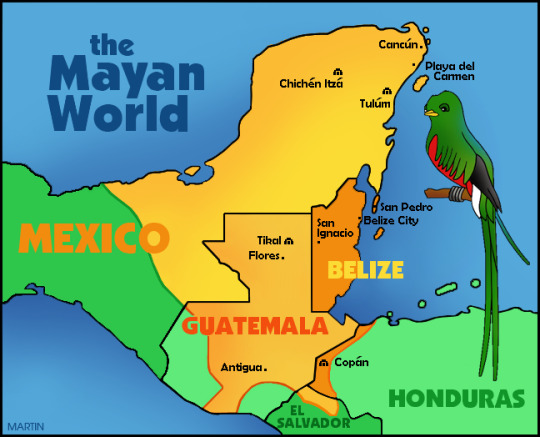
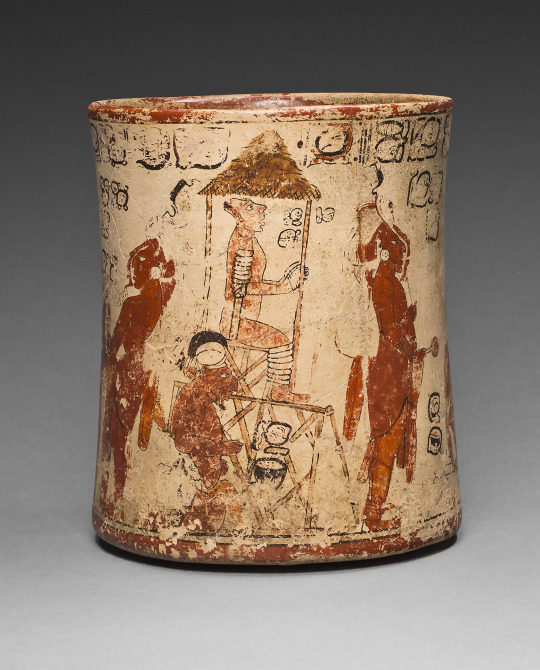
Vessel Depicting a Sacrificial Ceremony for a Royal Accession (650-800 CE)
September 25, 753 AD
This vessel, used to consume a chocolate drink, depicts a key event in a royal Maya accession ceremony, which shows the relationship between human sacrifice and the assumption of power. The expectant king is flanked by servants, musicians, and masked nobles, while a terrified captive—bound to a scaffold—awaits his death.
It is probable that the victim was a warrior from a rival community defeated by the prospective king during a coronation war. Such sacrifices were required as proof of a new ruler’s military abilities, provided an offering to his patron gods, and served as a sign of the triumphant reign to follow.

Vessel of the Dancing Lords (750-800 CE) Guatemala
According to ancient Maya belief, after several failed attempts the gods succeeded in populating the earth when they created humanity out of maize, the staff of life.
In the Popol Vuh, a sixteenth-century epic of the K’iche’ Maya, the death and resur¬rection of the maize god was likened to seed corn that sprouted and produced new life.
This vessel from the Late Classic period (600–800) depicts a Maya ruler attired as the maize god in three almost-identical panels. On his back, the ruler wears an enormous rack containing brilliant feathers, heraldic beasts, and related emblems. Just as maize plants sway to and fro, the maize god dances to the rhythm of life—often, as seen here, in the company of a dwarf.
Among the Maya, dwarfs were seen as special beings with powerful spiritual connections to the earth and the interior world below.
This vase refers to a rite of passage in which dwarfs assist the soul of the deceased into the domain of the dead, from which it would eventually be reborn in the royal lineage, just as maize sprouts again in the cycle of nature’s renewal.
This vase of the Dancing Lords may have been painted as a funerary offering for a noblewoman with dynastic connections in the city of Naranjo, where it was made.
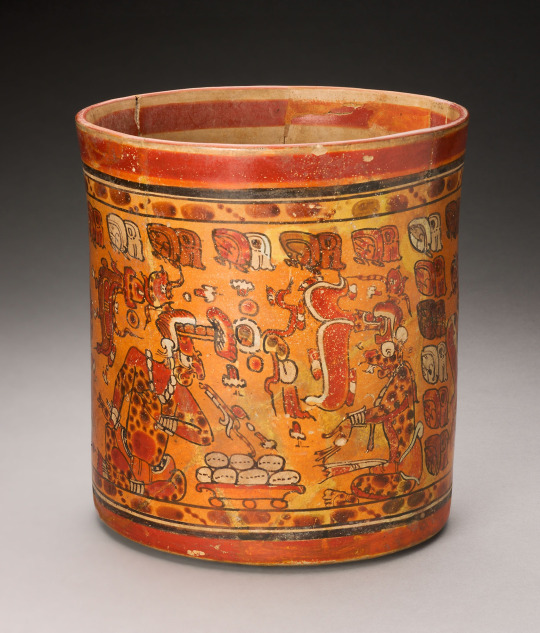
Vessel Depicting K’awiil (God K) and Itzamna Exchanging Gifts, (700/800 CE)
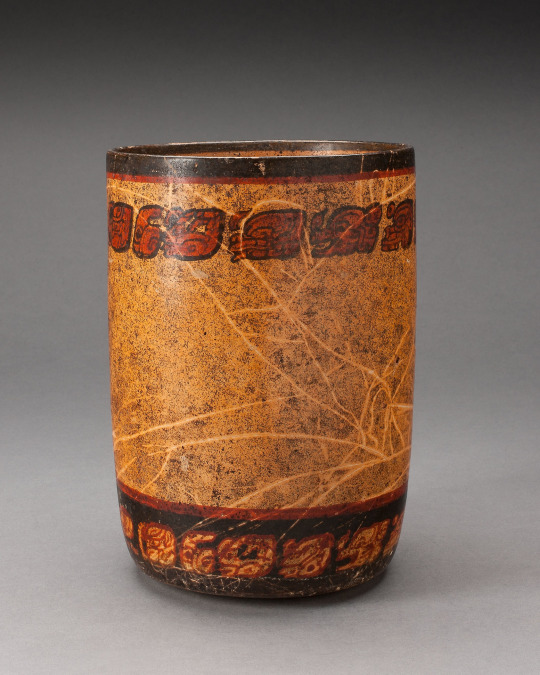
Cylindrical Vessel (250-900 CE)
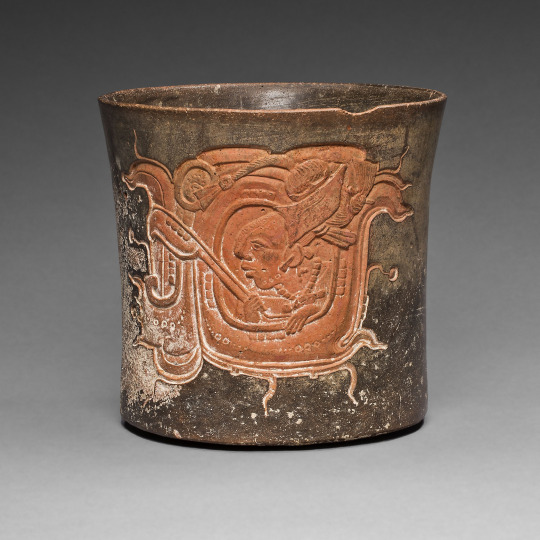
Carved Vessel Depicting a Lord Wearing a Water-Lily Headdress, (600/800 CE) holding a water paddle and left hand resting meaning.

Vessel Depicting a Mythological Scene (600-800 CE)
A God holding a conch shell, black markings indicating God status, and turtle below, the earth above the sacred waters. Aj Maxam is the artist.
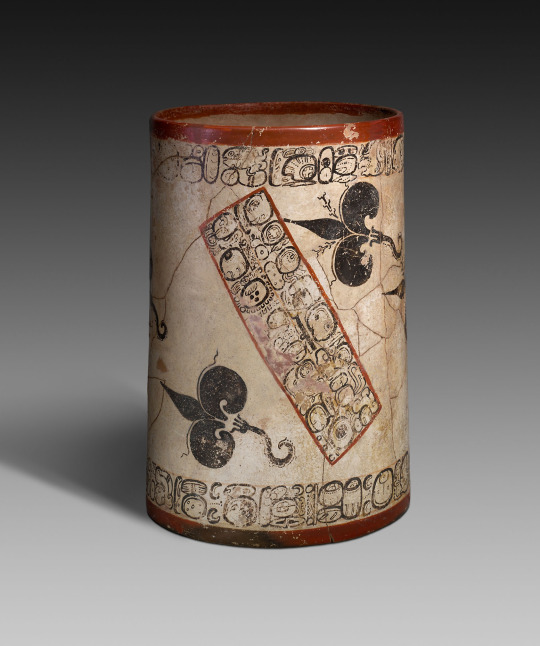
Water-Lily Vessel (750-800 CE)
The simple, elegant design of this vessel reflects the refined abilities of the artist, who painted images of water lilies and a hieroglyphic text with a perfectly controlled brush. The inscription below was the first to be deciphered on a Classic Maya vessel. It states the name of the artist, Ah Maxam (aj maxam), and declares that he is a member of the royal lineage of the kingdom of Naranjo. His mother and father are also named on this vessel, as well as on other dynastic monuments from the region. For the Maya, water lilies were symbolic of the watery surface of the Underworld and the earth’s regenerative powers.
The water world before human creation
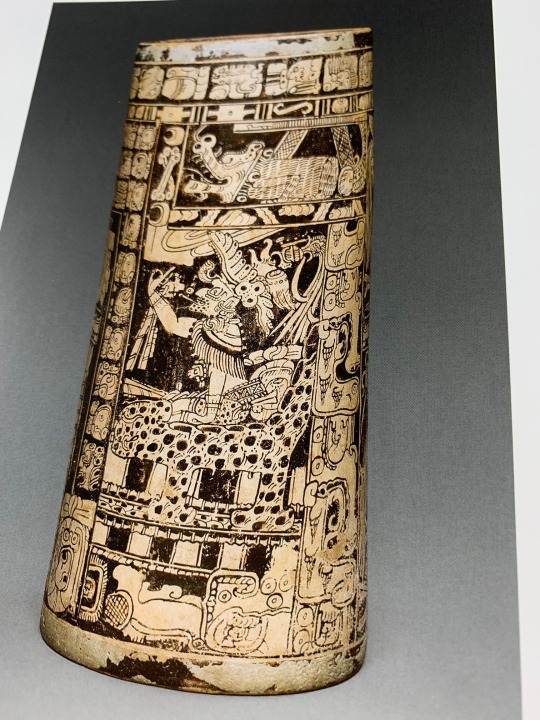
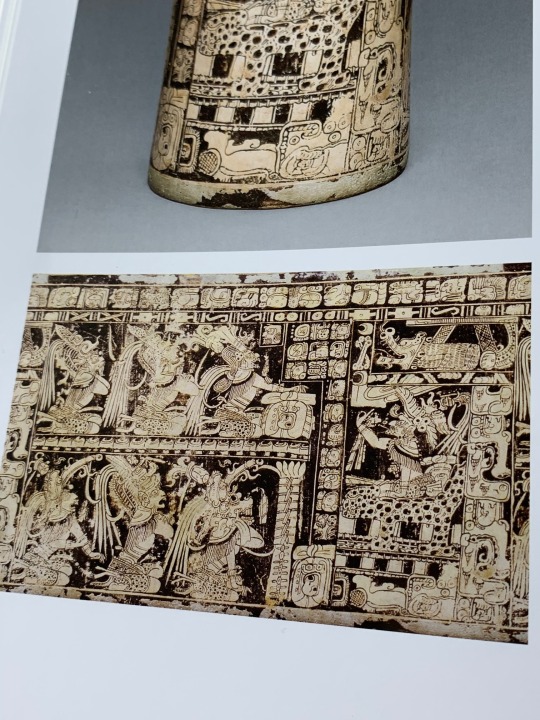
The Vessel of the Seven Gods
God L, Lord of the Underworld,, Jaguar pelt throne
August 13, 3114 BC panel, God L assembles the Gods, the Maize God emerges

Vase Depicting a Courtly Scene (600-800 CE)
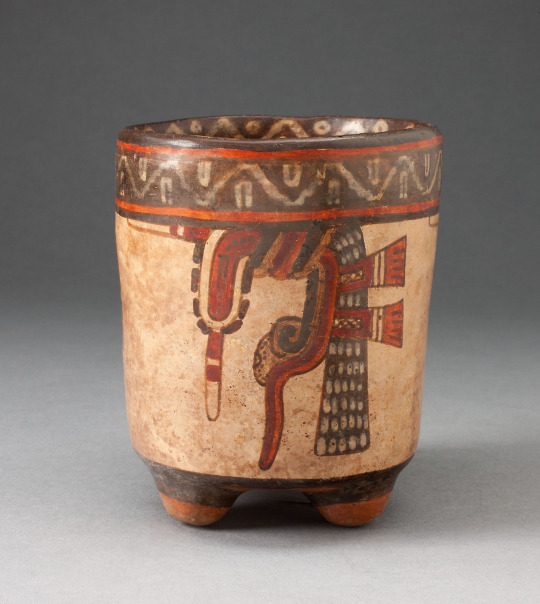
Tripod with Knotted Motif (850/950 CE)
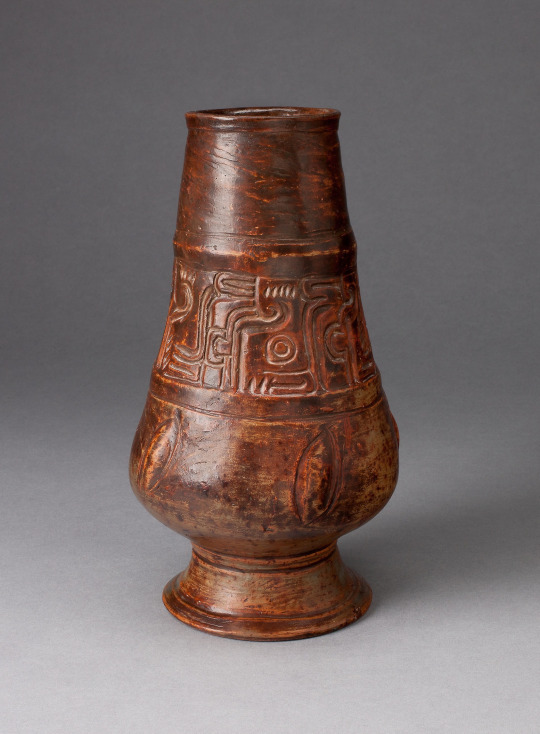
Footed Jar Incised with Pseudo-Gylphs (250/600 CE)
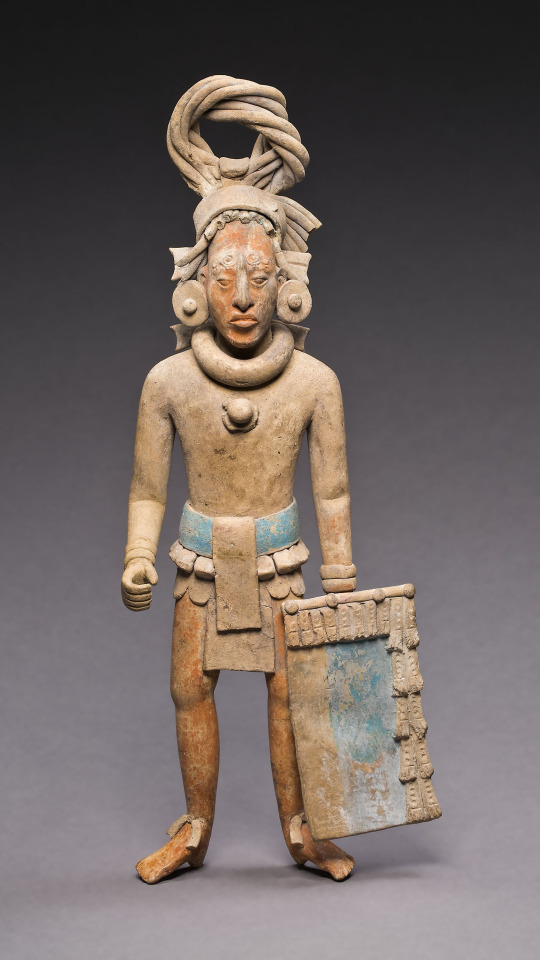
Figure of a Standing Warrior (650/800 CE)
Jaina
The costume and equipment of this figure indicate that he represents a warrior. He carries a rectangular shield and a long wooden spear (now lost), and the detailed attention given to the intricate headdress and facial features—marked by scarification, tattoos, and paint—suggests the portrait of a specific military commander.
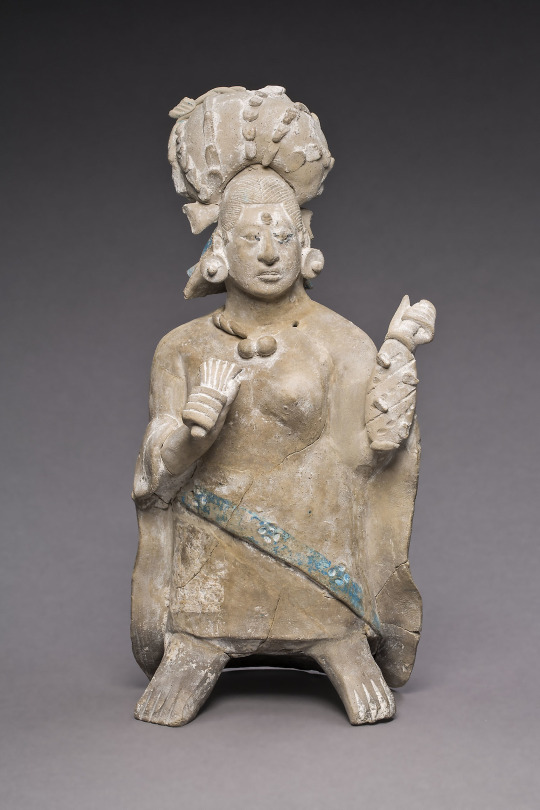
Figure of an Aristocratic Lady (650/800)
Jaina
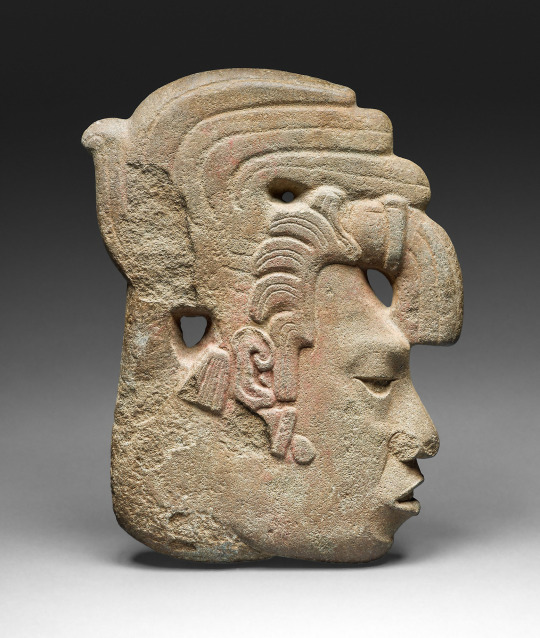
Royal Profile (650/800)
Ball Game Hacha, Maize God
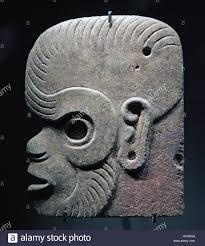
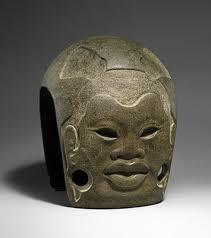
PALMAS
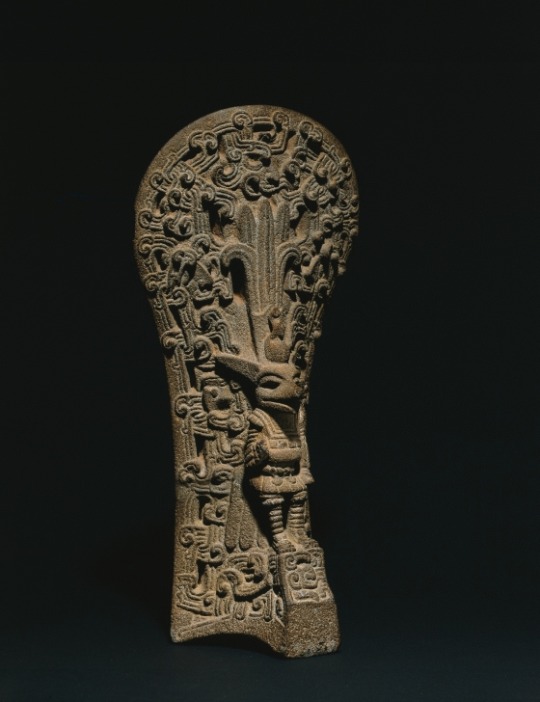
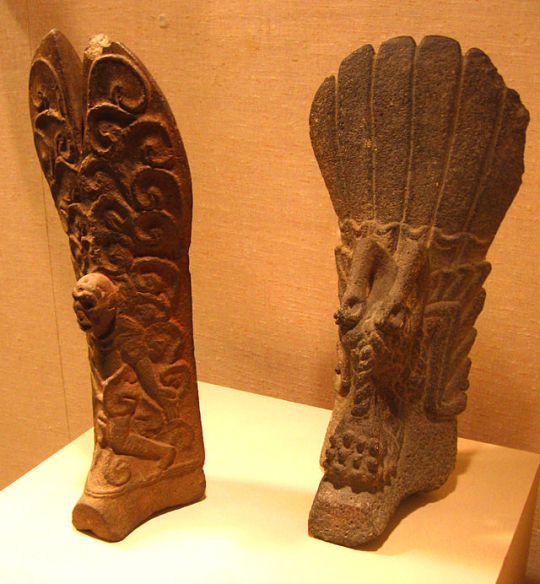
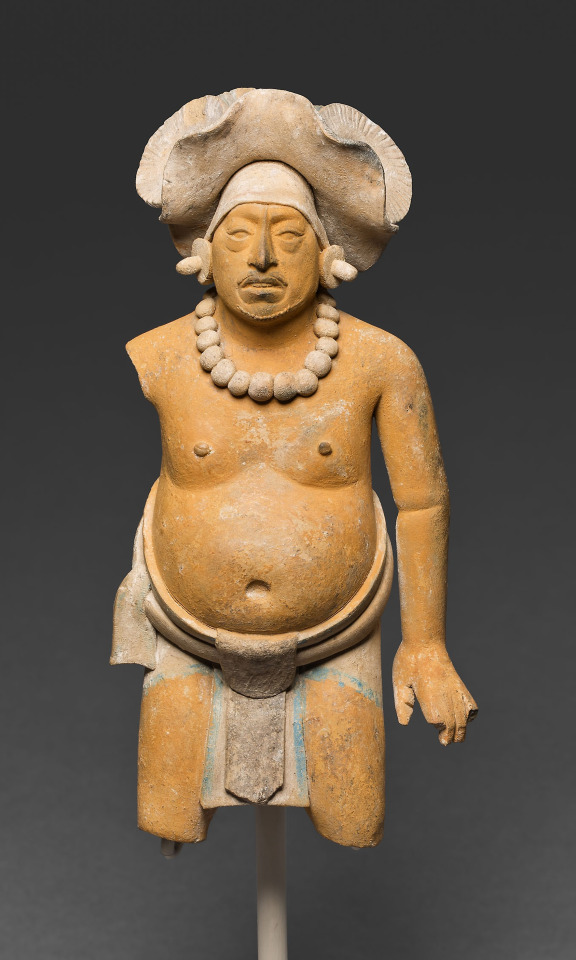
Standing Male Figure (650/800)
Jaina
Naturalistic Jaina figures often present detailed portraits of individuals. Men and women are delicately modeled in the poses, gestures, and costumes of those who ruled the Yucatán peninsula at the height of Classic Maya civilization, providing insight into their roles, status, and concerns. While most figures depict the social elite, such as ladies of the court, royal ballplayers, and priests, some also reflect interest in the range of Maya society members, including servants and captives wounded in battle.

Rattle in the Form of a Mythological Figure (650/800)
May be a dwarf
Jaina
Many of the hollow interiors of mold-made Jaina figurines were transformed into rattles or whistles. As musical instruments, they may have been played during the funerary ceremonies of the deceased whom they accompanied into the afterlife.

Ritual Vessel in the Form of a Head (600/900)
Yucatán
Flowering maize plant motif, scarification
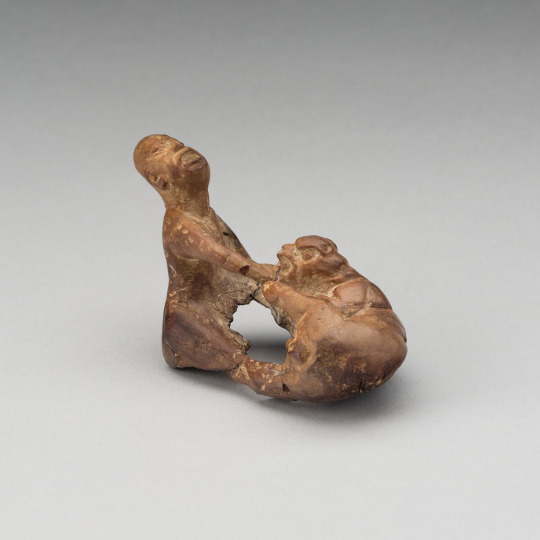
Figure of a Jaguar Attacking a Man (Probably 250/900)
Possibly Tabasco, Mexico
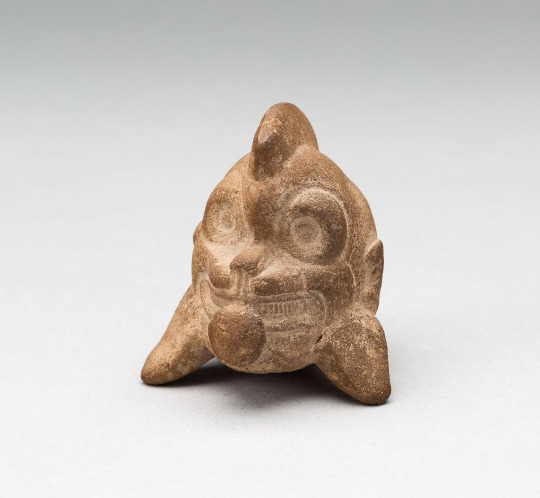
Whistle in the Form of the Head of a Jaguar (Possibly 250/900)
Possibly Jaina-style
Possibly Campeche, Mexico

Covered Vessel with the Principal Bird and Peccary Heads (200/300)
Petén region, Guatemala
This beautifully modeled and incised blackware vessel was likely was once the personal possession of a Maya king, who may have used it to serve food at royal feasts or who may have presented it as a gift to a visiting lord as a sign of alliance. Its shape—a lidded dish supported by four legs—was a form frequently produced during the Early Classic period [A.D. 250/450].
These ceramics often display a consistent set of motifs, with birds on their domed lids and inverted peccary (wild pig) heads serving as supports.
The artist who created this piece integrated the two-dimensional surface of the lid with its three-dimensional handle by connecting the bird’s spread wings, lightly incised into the surface, with its head, sculpted in the round. The vessel thus captures the essence of an aquatic bird floating on the surface of the water with its prey—a small fish—caught in its open beak.
Water birds and peccaries inhabited the natural landscape of the ancient Maya who associated them with the structure of the universe and the time of creation. The crest of feathers atop the bird’s head, its outstretched wings, and the bulge at the tip of its beak mark it as a cormorant.
The Maya regarded this bird as a liminal being, able to traverse three distinct environments: it flies in the sky, perches on land, and hunts fish by swimming deep under water. This was considered extraordinary, signifying the capacity to commune with supernatural beings that inhabit all three layers of the cosmos—a power that Maya kings also claimed to posses.
The cormorant bore many additional meanings with which these rulers wished to link themselves—for example, its association with watery realms alludes to fertility and agricultural abundance, which kings needed to ensure so that their community would survive. Water also evoked the distant mythological past, a time before the creation of the present universe when, according to Maya belief, everything was enveloped in a vast sea.
The peccaries furthered these cosmic associations as they are thought to have represented the four pillars that support the corners of the world. In addition, some Maya identified clusters of stars in the constellation Gemini as peccaries. This constellation is located in the region of the night sky where the seminal event of Maya creation—the resurrection of the maize god—was believed to have occurred.
All of these formal and iconographic features demonstrate that as a vessel made for a ruler and used in his court, this work was adorned with imagery designed to express the supernatural sources of his royal authority. In their art programs, Maya kings often associated themselves with the cosmos and the time f creation, thereby affirming that their right to rule was inherent in the world and was established at the beginning of time.
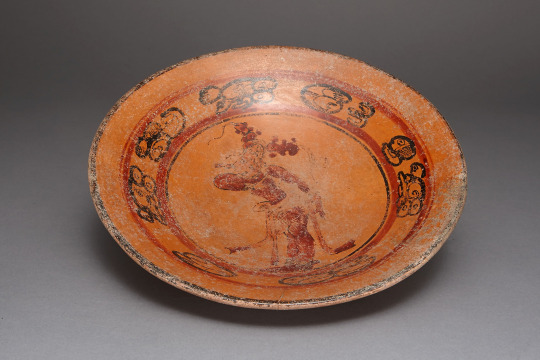
Plate Depicting a Dancing Figure (600/800)
Possibly Petén region, Guatemala

Plate in the Form of a Jaguar with Interior Painted with Floral-Like Motif (200/700)
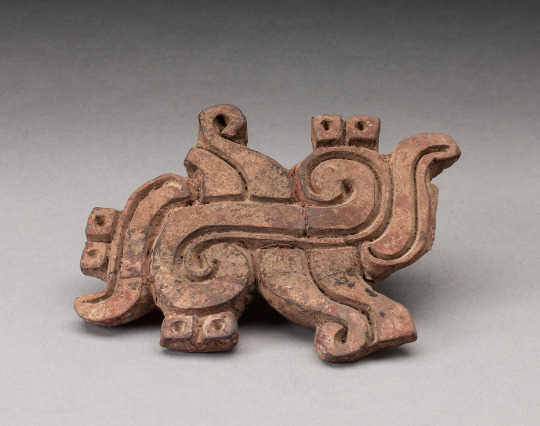
Stamp (300 B.C./A.D. 250)
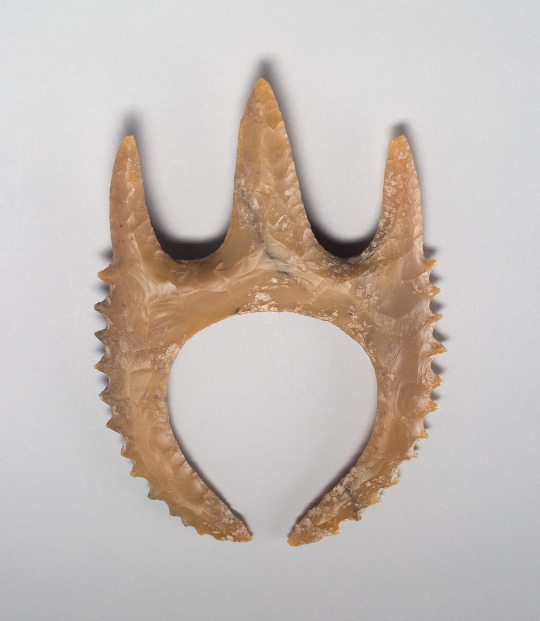
Eccentric Flint (200 CE)
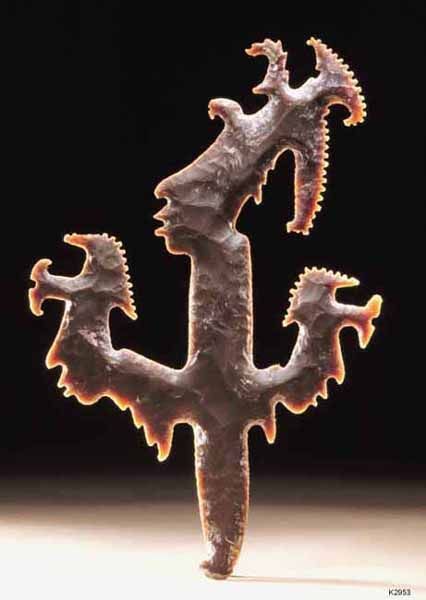
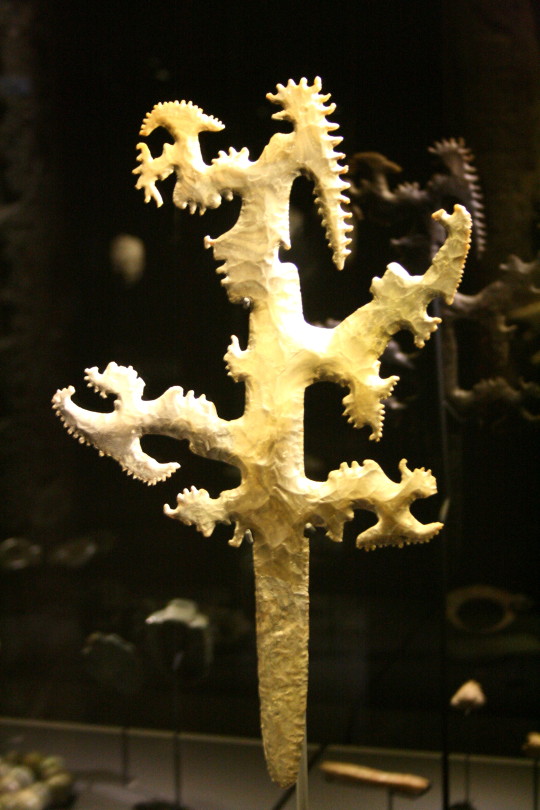
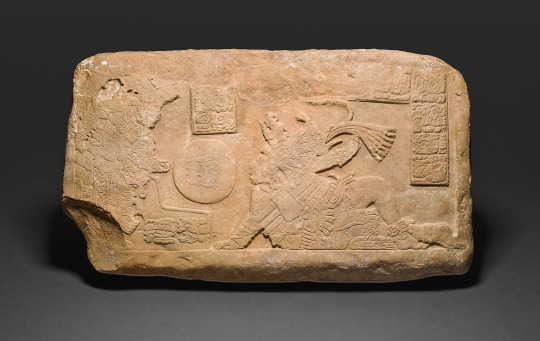
Ballplayer Panel (700/800)
Usumacinta River area, Mexico or Guatemala
In Central America, the best-known sculptors are the Maya, who decorated their temples and sacred precincts with finely carved stone reliefs representing powerful dynastic rulers involved in various secular and religious activities.
This fragmentary ball-court panel from the late eighth century shows two men, dressed in elaborate costumes, engaged in a ritual ball game. Surrounding the figures, and clearly set off from them, are fragments of hieroglyphs by which the Maya identified the players and the date on which the game occurred.
Calakmul Event
Great Turkey from La Corona, Guatemala on the right, and a ruler from Calakmul on the left.
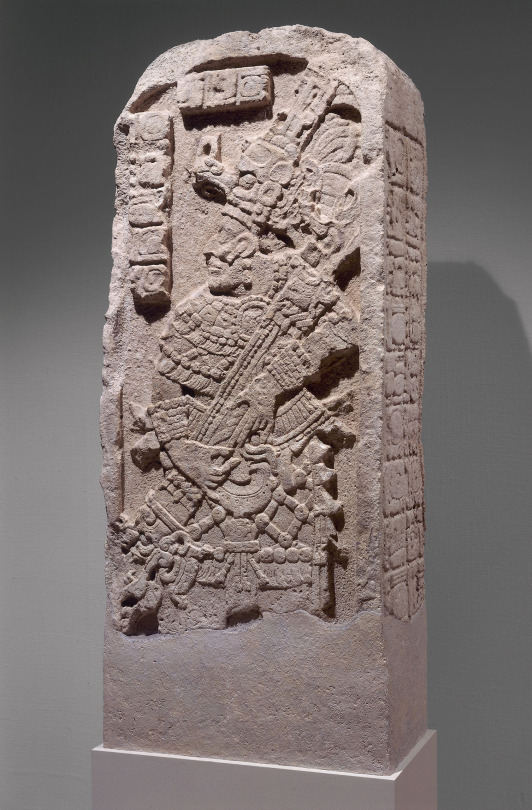
Stela (702 CE)
Vicinity of Calakmul, Campeche or Quintana Roo, Mexico
The lords of Maya city-states in southern Mexico, Guatemala, Belize, and Honduras portrayed themselves on stone monuments called stelae. Placed in plazas before the palaces and pyramids of ritual and administrative centers, these sculptures document critical information about major dynastic events between A.D. 200 and 900, including royal inaugurations, military triumphs, marriages, deaths, rituals, and key events of the agricultural cycle).
The carving style of the stela suggests that it may be from the vicinity of Calakmul, a major Classic Maya city located in Mexico’s Yucatán Peninsula, close to the border with the Petén district of Guatemala.
A male figure—likely a ruler—stands in a frontal position, with his head, lower legs, and feet (now missing) turned to the viewer’s left. The subject’s gaunt face suggests that he is elderly.
He holds a double-headed serpent bar across his body and is dressed in ceremonial attire associated with the Maize God, consisting of a plumed headdress, jade jewelry, a jade-netted kilt, and a spondylus seashell below the midriff. This costume symbolically connected the ruler to the earth, sky, water, and maize (corn).
Hieroglyphics carved on the left side of the monument record the date 9.13.10.0.0 in the Maya calendar, corresponding to January 26, A.D. 720, which marked the completion of a Maya 10-year period. The text on the right side documents the ritual auto-sacrificial bloodletting performed by the ruler to commemorate this significant moment in time. Although they are too highly eroded to read accurately, the hieroglyphs on the front of the stela likely name the ruler, his ancestry, and the place where he governed.
And the creation myth is depicted in the ruler
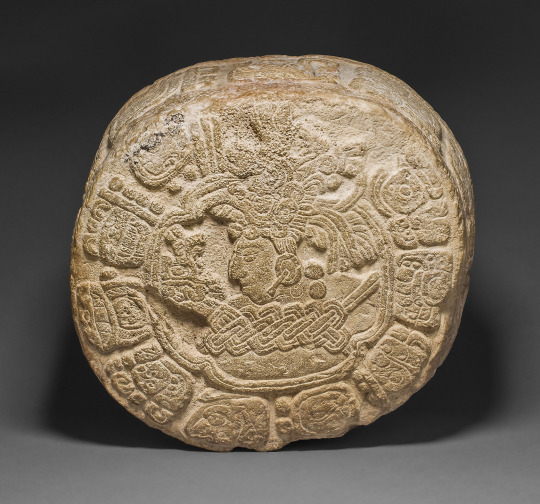
Hieroglyphic Altar (650/700)
Possibly Bonampak/Lacanha area, Mexico or Guatemala
This altar depicts the head and torso of an individual wearing an ornate headdress and a large, woven mat pectoral emblem of rulership. He appears within a four-lobed cartouche, suggesting that he is a deceased ancestor who lives in the Underworld.
The hieroglyphs that surround the figure describe the commemoration of a monument or structure; the text carved around the sides of the monument celebrate a successor’s completion of six years of kingship.
Holding the God K (dynasties and Lineages)
670 AD; From Bubbling Water

Hieroglyphic Panel (650/800)
Usumacinta River area, Mexico or Guatemala
The Maya developed hieroglyphic writing to record the names, births, marriages, alliances, victories and coronations, and deaths of their rulers.
Mythological events and religious happenings were also carefully chronicled. Today scholars are deciphering this script and linking the translated information to additional archaeological evidence in order to reconstruct ancient Maya history, belief, and culture. This fragment from a hieroglyphic panel contains calendrical information that was part of a longer text.

Pectoral (200/800)
This elegant chest ornament would have been part of a ruler’s ceremonial regalia. In Maya society, as among other Amerindian peoples, a ruler’s attire indicated rank, religious function, and place of origin. Such dress was highly regulated, and only members of the nobility wore jade and other greenstones as an expression of their wealth and high status. Moreover, these rare and valued stones were considered to be inherently sacred and powerful. By wearing jade regalia, kings directly associated themselves with the youthful green maize plant and life-giving blue-green waters.
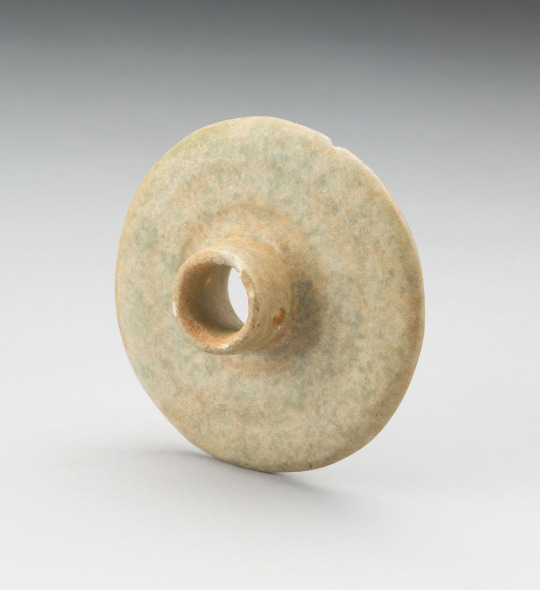
Ear Spool (250/900)
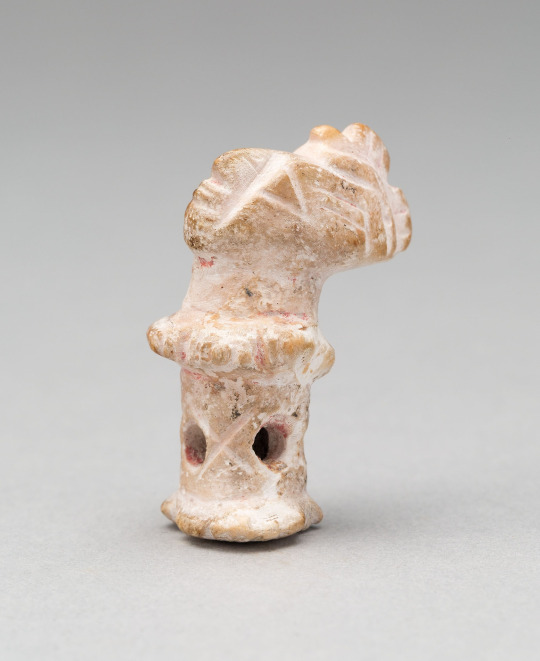
Labret (200/700)
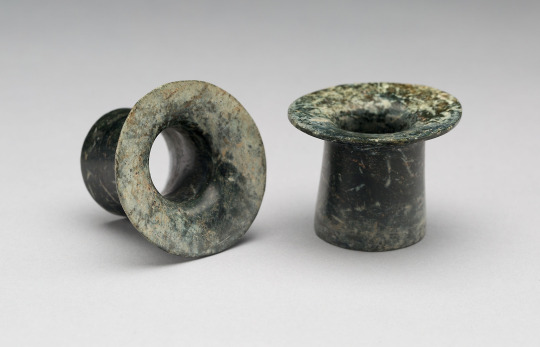
Pair of Ear Spools (250/900)
0 notes
Text

TRIPOD VESSEL (100-300 CE)

Shell, Possibly an Arm Band, Incised with Profile Head Framed by Geometric Motifs (1200 CE)

Miniature Mask; Wood, gold foil, and shell with pigment and resin (1300-1400 CE)

Mosaic Disk with a Mythological and Historical Scenes (Turquoise, earthenware, stucco, spondylus shell, mother of pearl, and iron pyrite, with pigment) 1400-1500 CE

On this disk, the sign for “year” and the date “3 Flint- Knife” (A.D. 1456) are associated with the image of the sun on the left; the date “4 House” (A.D. 1457) is linked by footsteps to the sun on the right. These dates mark the end of one 52-year cycle and the beginning of a new one. In the center, crossed darts symbolize a military alliance. Alliance members are represented by the skeletal figure at the left and the animal figure at the right. Below, a prone human form (damaged) signifies a sacrifice to confirm the association. The imagery of the disk stems from a long-established Mixtec tradition of pictorial manuscripts.
0 notes




